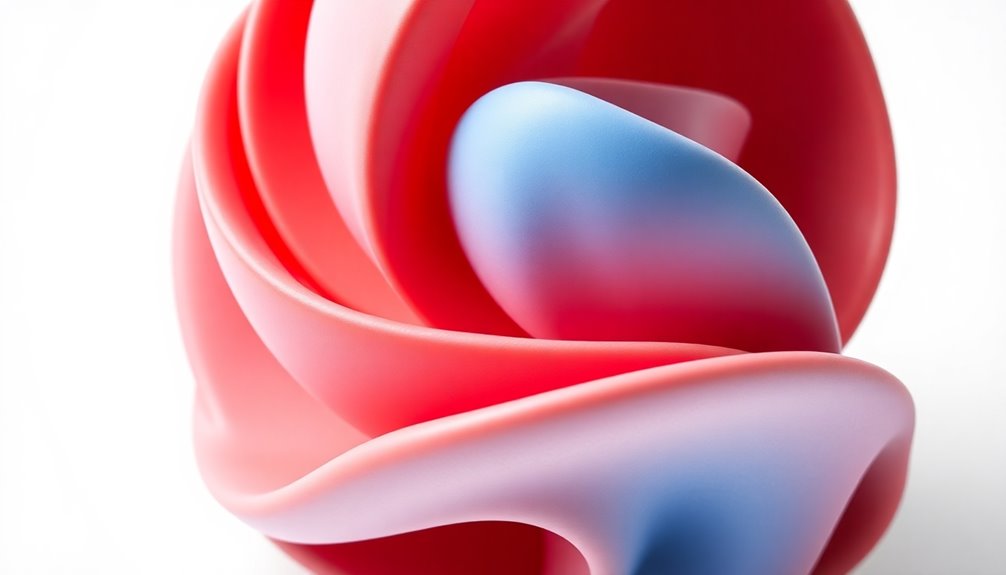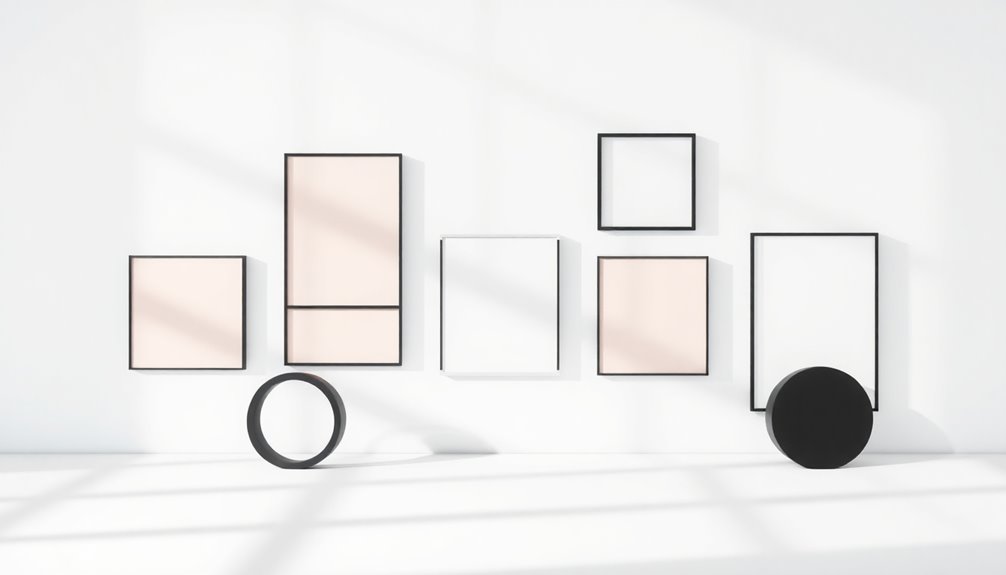Minimalist art redefines modern design by stripping away the superfluous, focusing on form, light, and emotional resonance. Artists like Agnes Martin invite tranquility with soft colors, while Donald Judd's geometric precision creates profound experiences. Sol LeWitt emphasizes concepts over execution, and Ellsworth Kelly showcases the vibrant power of abstraction. This interplay of simplicity and depth in art transforms spaces into engaging environments. Keep exploring to discover more about these visual masterpieces that shape contemporary design.
Key Takeaways
- Minimalist art prioritizes simplicity, using geometric shapes and monochrome palettes to create visually impactful designs in contemporary spaces.
- Influential artists like Donald Judd and Frank Stella have shaped modern design with their innovative use of industrial materials and spatial relationships.
- Minimalism encourages viewer interaction, fostering contemplative environments that invite reflection and inner peace within modern architectural practices.
- The integration of light as a sculptural element in minimalist art enhances the emotional resonance of spaces, blending aesthetics with functionality.
- Key masterpieces, such as Judd's "Monument for V. Tatlin," exemplify the fusion of artistic purity and contemporary design principles.
The Essence of Minimalism in Art

Minimalism in art strips away the unnecessary, allowing you to focus on the essence of form and material. This movement emphasizes simplicity and clarity, often showcasing geometric shapes and monochrome palettes.
You'll notice how influential artists like Frank Stella and Donald Judd challenge traditional conventions by prioritizing artistic expression through form and materiality rather than narrative. The mantra "What you see is what you see" perfectly encapsulates this philosophy, urging you to engage directly with the visual elements.
Minimalist art frequently incorporates industrial materials, reflecting a shift towards installation art that interacts with its environment. The integration of intelligent tutoring systems can also be seen as a minimalist approach to education, focusing on personalized learning experiences that enhance understanding.
Rooted in Zen Buddhism, minimalism embraces themes of emptiness and simplicity, shaping the aesthetic and conceptual foundations of contemporary visual art.
Agnes Martin: The Poet of Silence

Agnes Martin's art embodies the essence of Zen principles, inviting you to experience tranquility through her subtle grids and soft colors.
You'll find that her use of monochrome and minimalism not only simplifies the visual landscape but also enhances emotional resonance.
As you engage with her work, you'll discover a profound connection to silence and introspection that resonates deeply within. Her artistic approach mirrors the principles of bathroom renovation, where simplicity and functionality create a serene environment.
Embracing Zen Principles
While exploring the serene world of modern design, you can't help but notice the profound influence of Zen principles, particularly through the work of Agnes Martin.
As a pivotal figure in the Minimalist art movement, she embodies simplicity and beauty in her paintings. Her delicate grid patterns evoke an emotional response, inviting you to experience tranquility.
- Emphasizes inner peace
- Reflects natural landscapes
- Celebrates systematic repetition
- Inspires joy and serenity
- Represents the artist's inner self
Martin's philosophy suggests that art should resonate with happiness, transforming her canvases into silent poetry. Additionally, her approach aligns with the concept of vibrational alignment found in the Law of Attraction, which emphasizes the importance of inner feelings in manifesting desired realities.
Monochrome and Minimalism
Although often understated, the power of monochrome in Agnes Martin's work resonates deeply, capturing the essence of her artistic philosophy.
Her minimalist approach emphasizes simplicity, with delicate color palettes and subtle pencil-drawn grids that invite contemplation. You'll find that each piece embodies a serene beauty, drawing you into a space of reflection.
Martin believed that art should evoke emotional responses, conveying happiness and peace through minimalistic forms. This connection to Zen Buddhism and American Transcendentalism is evident, as her works foster an introspective atmosphere.
Her renowned piece, "Untitled #6," which recently sold for over $5 million, showcases her lasting influence and the emotional depth present in her monochrome masterpieces.
Agnes Martin truly becomes a poet of silence through her art. Additionally, her work can be seen as a form of divine communication, where the simplicity and tranquility serve to connect the viewer with deeper spiritual truths.
Emotional Resonance in Art
Emotional resonance permeates Agnes Martin's art, inviting viewers into a contemplative domain where silence speaks volumes.
Her minimalist paintings, characterized by soft colors and simple grids, create a space for reflection and inner peace. You'll find that her works not only evoke beauty and happiness but also foster a meditative experience that transcends traditional art forms.
- Each piece invites personal interpretation.
- Repetitive patterns embody tranquility.
- Subtle hues enhance emotional connections.
- Silence amplifies the weight of emptiness.
- Simplicity reveals profound emotional depth.
Through her unique approach, Martin encourages you to explore the depths of your own emotions, solidifying her legacy as "the poet of silence" in the art world. Additionally, her art mirrors the cultural beliefs surrounding aesthetics, further enriching the viewer's experience.
Donald Judd: Geometry and Color

When you explore Donald Judd's work, you can't help but notice his geometric precision and vibrant use of color.
His sculptures challenge your perception of space, inviting you to contemplate how simplicity can create impact.
Judd's approach not only defines Minimalism but also influences modern design by emphasizing clean lines and functional beauty. Additionally, his work resonates with the idea of cultural significance in art, often reflecting deeper meanings and connections within the minimalist aesthetic.
Geometric Precision in Art
Donald Judd's work exemplifies the power of geometric precision in art, showcasing how simple forms can create profound experiences. His minimalist sculptures often utilize industrial materials, reinforcing the connection between the object and its environment.
By employing precise measurements and symmetry, Judd creates a sense of order that invites viewers to engage deeply with his pieces.
- He challenges traditional artistic boundaries.
- His "Untitled" series highlights repeated geometric forms.
- Judd's works encourage interaction with space.
- Minimalism emphasizes both functionality and simplicity.
- His influence shapes contemporary architecture and design.
Through his innovative approach, Donald Judd redefined how we perceive art, proving that geometric precision can evoke powerful emotional responses. Additionally, his focus on sustainable materials reflects a growing trend in contemporary art practices that prioritize environmental consciousness.
Vibrant Color Exploration
While many artists rely on intricate narratives, Donald Judd focuses on the powerful dialogue between geometry and vibrant color. His iconic works, like "Untitled (Stack)" from 1967, showcase geometric forms crafted from industrial materials, emphasizing how color enhances the perception of structure.
You'll notice that Judd often employs a limited palette of primary colors, which invites you to explore the interplay between color, form, and space. This approach creates a unique visual experience, allowing you to appreciate the simplicity and boldness of his designs.
Judd's meticulous attention to both form and hue encourages modern designers to integrate vibrant colors into contemporary interiors, proving that minimalism doesn't have to be muted or dull. Additionally, his work resonates with the current trend of sustainability in design, as it promotes the use of industrial materials that can reduce environmental waste.
Impact on Minimalism
The vibrant colors and geometric forms championed by Donald Judd markedly influenced the Minimalist movement, shifting perceptions of art and design.
You'll find that Judd's emphasis on the object itself, rather than illusion, reshaped the Minimalism art movement. His innovative use of industrial materials and focus on spatial relationships created a new dialogue between art and viewer.
- Challenged traditional artistic representations
- Advocated for simplicity and physicality
- Introduced stacks of cantilevered boxes
- Influenced modern design principles
- Inspired ongoing discussions around "Specific Objects"
Judd's work remains relevant, as evidenced by the recent sale of "Untitled" for over $8 million, underscoring his lasting impact and the enduring appeal of Minimalism. Additionally, his approach reflects the principles of intentional living, emphasizing a purposeful connection between the viewer and the art itself.
Sol LeWitt: Ideas as Art

Conceptualization reigns supreme in Sol LeWitt's approach to art, where the essence of an idea takes precedence over the final piece. As a pioneering Minimalist, he believed that the concept behind a work is more vital than its execution. His famous statement, "The idea becomes a machine that makes the art," captures this philosophy.
LeWitt created over 1,350 wall drawings, utilizing geometric forms and systematic processes, allowing for endless reinterpretations by different artists. His simple instructions lead to complex visual results, emphasizing conceptual art over traditional aesthetics.
Additionally, his three-dimensional "Structures" blend Minimalist principles with architectural design, further showcasing his innovative approach. LeWitt's influence encourages you to prioritize ideas and challenge conventional artistic norms. His work is a testament to the importance of customer feedback in shaping artistic and business strategies, as it fosters continuous improvement and innovation.
Ellsworth Kelly: The Power of Abstraction

Though often overlooked, Ellsworth Kelly's contributions to Minimalism showcase the profound power of abstraction in modern design. His vibrant colors and organic forms simplify visual complexity, inviting you to engage deeply with his work.
Pieces like "Red Yellow Blue 3" exemplify his mastery of chromatic harmony, allowing colors to evoke emotional responses.
- Emphasizes pure abstraction
- Eliminates the artist's hand
- Focuses on geometric shapes
- Inspires future generations
- Redefines contemporary art
Kelly believed art should exist independently, free from external references. His innovative approaches to abstraction and color have left a lasting impact on the Minimalist movement, encouraging you to explore the boundaries of form and perception in your own artistic journey.
Frank Stella: Non-Representational Innovation

Building on the foundation laid by artists like Ellsworth Kelly, Frank Stella emerges as a pivotal figure in the Minimalist movement, pushing the boundaries of non-representation.
His iconic "Black Paintings" from the late 1950s utilize monochromatic black paint and geometric patterns, challenging traditional depth and perspective. By embracing a self-referential approach, Stella's mantra, "What you see is what you see," reflects his commitment to art stripped of narrative or emotional content.
He didn't stop at paint; his innovative three-dimensional works incorporated shaped canvases and materials like aluminum and stainless steel, further expanding the Minimalist aesthetic.
With pieces like "Point of Pines" fetching over $28 million at auction, Stella's impact on both art and design remains profound and enduring.
Anne Truitt: Emotion Through Form

When you explore Anne Truitt's work, you can see how she merges sculptural geometry with deep emotional resonance.
Her handcrafted approach sets her apart from industrial processes, allowing you to feel a personal connection to her art.
Through her carefully constructed forms and colors, Truitt invites you to experience beauty and happiness in a tangible way.
Sculptural Geometry Exploration
As you explore the world of sculptural geometry, Anne Truitt's work stands out for its unique ability to convey emotion through seemingly simple forms.
Her sculptures, often defined by bold geometric shapes and a delicate balance of color, invite introspection and connection. You'll appreciate the meticulous hand-making process that highlights her craftsmanship and emotional resonance.
- Truitt's Minimalist pieces reflect themes of solitude.
- Each sculpture offers a psychological experience of form.
- Her work emphasizes the relationship between sculpture and painting.
- "Prescience," a notable piece, sold for $317,500, showcasing her impact.
- Truitt draws inspiration from her environment, enriching her sculptural geometry.
Dive into her creations and discover how geometry can evoke profound feelings.
Emotional Resonance in Art
Through the lens of Anne Truitt's work, emotional resonance in art emerges as a powerful force that transcends mere aesthetics. Her Minimalist sculptures, characterized by bold geometric shapes and vibrant colors, evoke deep emotional and psychological responses.
You'll notice how Truitt's careful attention to light and shadow invites you to engage with the physical space and emotional context of her pieces. Works like "Prescience" reflect her preference for hand-crafted techniques, imbuing a personal touch that enhances intimacy.
Truitt believed beauty and happiness are essential in art creation, which resonates with viewers through her systematic repetition and curated color palettes. Ultimately, her sculptures embody both simplicity and profound emotional narratives, making significant contributions to art history.
Handcrafted vs. Industrial Process
Anne Truitt's work exemplifies the profound impact of the handcrafted approach in art, particularly when set against the backdrop of industrial processes.
Her handcrafted sculptures highlight emotional expression through geometric forms, creating a personal connection that industrial methods often lack. In contrast to the sterile nature of Minimalist art, Truitt's pieces invite viewers to engage with the artist's intent and emotional resonance.
- Handcrafted art fosters authenticity and individuality.
- Industrial processes can lead to uniformity and detachment.
- Truitt's vibrant colors enhance emotional depth.
- Geometric forms in her work reflect simplicity and clarity.
- The human touch in her sculptures evokes deeper connections.
Through her creations, Truitt demonstrates how handcrafted methods enrich the artistic experience, emphasizing the importance of intention and emotion.
Robert Ryman: The Art of White

While many artists embrace a spectrum of colors, Robert Ryman found profound depth in the simplicity of white. His iconic white-on-white paintings reveal subtle variations in hue, texture, and light, showcasing his mastery in minimalist contemporary art.
By employing unconventional materials like oil, acrylic, and enamel on canvas, Ryman explored the physical properties of paint, challenging traditional notions of color. His background in jazz influenced his rhythmic approach to composition, creating dynamic spatial relationships within his pieces.
Although he preferred to be seen as a Realist, Ryman's work undeniably contributed to the Minimalist movement. The recent sale of his painting "Gate" for £2,500,000 underscores the lasting impact of his innovative vision on the art world.
Dan Flavin: Transforming Light Into Art

Light serves as both medium and subject in Dan Flavin's transformative art. By using fluorescent light tubes, he creates immersive installations that redefine architectural spaces. His minimalist approach emphasizes the interaction of light and geometry, changing how you perceive your environment.
- Integrates light as a sculptural element
- Rejects traditional mediums like painting
- Focuses on industrial materials
- Celebrates the materiality of light
- Influences contemporary minimalist practices
Flavin's iconic series, "Monument for V. Tatlin," exemplifies this philosophy, blending homage to Russian Constructivism with a minimalist aesthetic.
His installations, showcased in places like Dia Beacon in New York, demonstrate the lasting impact of his innovative use of light on modern design.
Ad Reinhardt: The Pursuit of Pure Abstraction

Ad Reinhardt's pursuit of pure abstraction revolutionized the way we think about painting and its role in art. Known for his monochromatic black canvases, Reinhardt stripped away representational content to achieve an artistic purity that resonates deeply with the Minimalist movement.
His iconic work, "Red Painting," showcases his commitment to the materiality of paint, demonstrating that art doesn't need to convey emotions or narratives. Reinhardt famously declared, "Art is art, everything else is everything else," emphasizing the autonomy of artistic expression.
Frequently Asked Questions
What Is Modern Minimalist Art?
Modern minimalist art is all about simplicity and clarity.
It emerged in the 1960s, reacting against more emotional art movements.
You'll notice geometric shapes, flat surfaces, and a limited color palette that focus on the material and spatial relationships of the artwork.
Artists like Donald Judd and Agnes Martin emphasize "less is more," inviting you to contemplate and reflect on the essence of the piece without complex narratives or distractions.
Who Is the Most Famous Minimalist?
When you think about minimalist art, Donald Judd often comes to mind as one of the most famous figures. His geometric sculptures and influential writings, especially "Specific Objects," shaped the movement considerably.
However, Agnes Martin and Frank Stella also stand out. Martin's serene grid paintings and Stella's vibrant works highlight the diversity within minimalism.
Each artist brings a unique perspective, but Judd's impact remains particularly prominent in the art world.
What Are the 3 Characteristics of Minimalism Art?
Imagine walking into a space where simplicity reigns, and every detail has purpose.
In minimalist art, you'll find three key characteristics: extreme simplicity, where less truly is more; geometric forms that create a sense of order; and a limited color palette that emphasizes structure over emotion.
This stripped-down approach invites you to engage with the essence of the artwork, allowing the material and space to come alive in your experience.
Which of the Following Is a Famous Minimalist Artist?
When you think about famous minimalist artists, a few names stand out.
Donald Judd's geometric sculptures and stacks are iconic, while Agnes Martin's subtle grid paintings evoke emotional depth.
Frank Stella's Black Paintings redefine traditional painting with their focus on the canvas itself.
Sol LeWitt's wall drawings highlight the importance of concept, and Ellsworth Kelly's vibrant colors celebrate simplicity.
Each of these artists has greatly contributed to the minimalist movement and its lasting impact.
Conclusion
In the world of modern design, minimalist art shines like a beacon, guiding us toward clarity and introspection. Each artist, from Agnes Martin's whispers of silence to Dan Flavin's luminous transformations, invites you to strip away the noise and embrace simplicity. Think of minimalism as a clear sky after a storm—refreshing and full of possibility. As you navigate your own creative journey, let these masterpieces inspire you to find beauty in the essential, illuminating your path forward.









